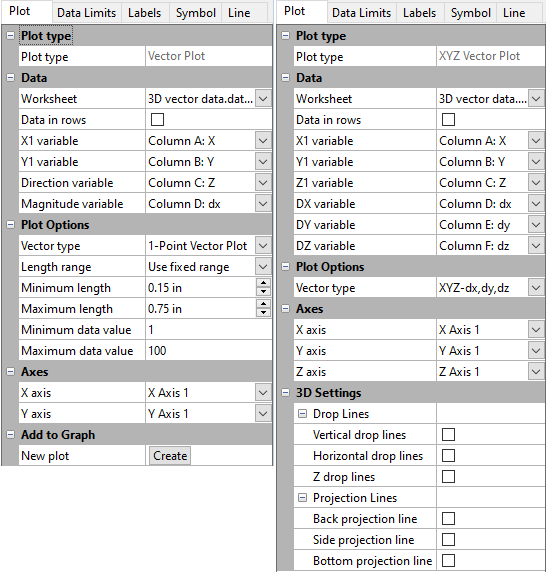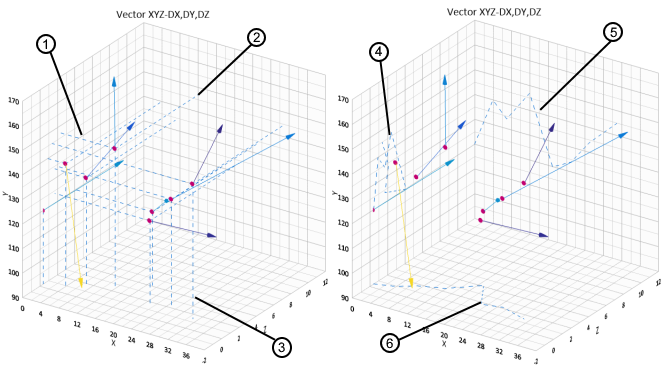Plot Page - Vector Plots
The vector plot properties Plot page contains the options to change the data file and axes, set data used in the plot, set vector properties, and add a new plot to the graph. To view and edit vector plot properties, click on the vector plot in the plot window or Object Manager to select it. Then, click on the Plot tab in the Property Manager. The properties available will be specific to the type of plot.
Click one of the Plot page section names in the list below to read more information about the properties in those sections or follow this help topic sequentially to read about each property.
|
|
|
Example vector plot properties in the Property Manager on the Plot tab. |
Plot Type
The Plot type property displays the type of plot.
Data
Worksheet
Click the existing data file path and file name next to Worksheet to select a different data file for the plot. Click on a currently open worksheet or click the Browse option to navigate to a worksheet that is not yet open. Select a different data file in the Open Worksheet dialog, and click the Open button to change the data. The plot automatically updates.
NOTE: The worksheet columns are retained after changing the worksheet. If any of the column options are blank after changing the Worksheet, click on the blank option and select the desired column. A blank next to column means that the column does not exist in the new worksheet.
Select the Data in rows option if your data file is formatted where each row includes one variable. When the Data in rows option is selected, all plot properties that require data values are specified by selecting a data row. This includes variables such as X and Y, data labels, worksheet ranges, etc. Properties that list column letters will update to list row numbers. When switching from plotting data in columns to plotting data in rows, Grapher may not be able to select the correct rows automatically. Verify the correct rows are selected.
The property descriptions below refer to data columns, but when Data in rows is selected the property lists will include rows.
Variables
Click on the column name next to the X variable, Y variable, X1 variable, Y1 variable, Z1 variable, X2 variable, Y2 variable, Z2 variable, Direction variable, Magnitude variable, DX variable, DY variable, or DZ variable fields to change the columns used to create the plot. In the list that appears, select the new column. If the first worksheet row contains header information, the header information appears next to the column letter.
Aside from the columns containing data there are two other options, row number and sequence number. These options are available in the list that appears before the first column.
- Selecting the Row number option plots the axis with the row numbers used in the Worksheet rows section. For example, if the first row is number two, the axis begins at a value of two.
- The Sequence number option plots the data according to the total number of rows used. The sequence number always begins with the number one regardless of which rows are selected in the Worksheet rows group. Blank lines between rows are ignored when calculating the value. The sequence number increments by one when rows are adjacent or when rows are skipped.
When changing the X variable, Y variable, X1 variable, Y1 variable, Z1 variable, X2 variable, Y2 variable, Z2 variable, Angle variable, Magnitude variable, DX variable, DY variable, or DZ variable to date/time data from numeric data, the Use date/time format option for the corresponding axis Tick Labels will automatically be checked to match the new data. When changing the data to numeric data from date/time data, the Use date/time format option for the corresponding axis Tick Labels will automatically be unchecked to match the new data.
NOTE: The worksheet columns are retained after changing the worksheet. If any of the column options are blank after changing the Worksheet, click on the blank option and select the desired column. A blank next to column means that the column does not exist in the new worksheet.
Plot Options
Vector Type
Click the Vector type field to choose the format in which to display the vector data.
For a 2D vector plot, the choices are 1-Point Vector Plot and 2-Point Vector Plot. The 1-Point Vector Plot option contains a starting XY position and angle direction and magnitude values. The vectors are drawn from the XY position to the point determined by the direction and magnitude values. The 2-Point Vector Plot option contains two XY positions that are connected by a vector.
For an XYZ vector plot, the choices are 2-Point Vector Plot and XYZ-dx,dy,dz. The 2-Point Vector Plot option contains two XYZ positions that are connected by a vector. The XYZ-dx,dy,dz option contains a starting XYZ position and distances in each of the X, Y, and Z directions for the vector. The vectors are drawn from the XYZ position to the point determined by the dx, dy, dz values.
Length Range
When the Vector type is set to 1 Point Vector Plot, the Length range option becomes available. Click the Length range field to choose between Use data range (plot data) and Use fixed range (assigned setting) for the minimum and maximum length. To change the Length range, click on the existing option and select the new option from the list.
Minimum and Maximum Lengths
The Minimum length and Maximum length fields are the smallest and largest vectors defined when the Use data range is selected for the Length range option. When the Length range option is set to Use fixed range, the Minimum length and Maximum length are the defined lengths for the Minimum data value and Maximum data value.
Minimum and Maximum Data Values
When the Length range is set to Use fixed range, the Minimum data value and Maximum data value options become available. Click the Minimum data value and Maximum data value fields to set the data values for the minimum and maximum lengths. These values are in the Magnitude variable units.
Axes
Click on the axis name next to the X axis, Y axis, or Z axis fields to change the axes used for the plot. Select another axis name from the list. Alternatively, click Select plots/axis to change the axis used by several plots on a graph at once. See the Axis - Add to Graph help topic for information about how to add a new axis to the graph. Once the new axis is added to the graph, it will be available in the X axis, Y axis, or Z axis lists.
Add to Graph
Click the Create button next to the New plot command to create a new plot based on the current data file. The Create button is not available for an XYZ vector plot. A new plot is created using the same X1 variable and Y1 variable as the selected plot. The X2 variable and Y2 variable, or Direction variable and Magnitude variable, change to the next columns in the worksheet that contain data. For example, if a selected vector plot uses columns A and B for the X1 variable and Y1 variable and columns C and D for the X2 variable and Y2 variable, clicking Create generates a new vector plot with columns A and B for the X1 variable and Y1 variable and columns E and F for the X2 variable and Y2 variable. The new vector plot is selected so you can change the new plot's properties.
3D Settings
Drop Lines
3D XYZ plots have vertical, horizontal, and Z drop line options. When the box next to Vertical drop lines is checked, lines are drawn from the points to the bottom wall (XZ plane). When the box next to Horizontal drop lines is checked, lines are drawn from the point to the side wall (YZ plane). When the box next to Z drop lines is checked, lines are drawn from the point to the back wall (XY plane).
Drop Axis
When the Vertical drop lines or Horizontal drop lines box is checked, you can choose the plane to which the lines are drawn. Drop lines are drawn from the data point to the plane that intersects the drop axis minimum. You can set axes minimums in the Data Limits property page.
- For vertical drop lines, the XZ plane to which the drop lines are drawn is specified by the Vert drop axis minimum location.
- For horizontal drop lines, the YZ plane to which the drop lines are drawn is specified by the Horz drop axis minimum location.
- Z drop lines are always drawn to the XY plane at the Z axis maximum. There is no Z drop axis property.
Drop Line Frequency
If there are many drop lines, you can change the frequency the lines are drawn by entering a new number into the Line frequency box. For example, if Line frequency is set to 5, every fifth line is plotted on the plot. To remove all of the lines, set the Line frequency to a number greater than the total number of data points. Up to 10,000 points may be skipped.
Projection Lines
Projection lines are also available for 3D XYZ plots. Projection lines are 2D representations of the 3D lines and appear on the various axis walls. Check the boxes next to the Back projection, Side projection, or Bottom projection options to add one, two, or all three of these projection lines to the graph. The Back projection option places the XY projection on the back wall of the graph. The Side projection option places the YZ projection on the side wall. The Bottom projection places the XZ projection on the bottom wall.
The projection line properties
can be controlled in the Projection
line properties section on the Line
page. Click the ![]() next to the Projection line properties
section to open the line properties options. The Style,
Color, Opacity, and Width
can be changed for the projection lines.
next to the Projection line properties
section to open the line properties options. The Style,
Color, Opacity, and Width
can be changed for the projection lines.
3D Drop and Projection Lines Examples
- Horizontal drop line
- Z drop line
- Vertical drop line
- Side projection line
- Back projection line
- Bottom projection line
|
|
|
Example 3D drop and projection lines in a 3D vector plot |

